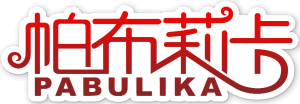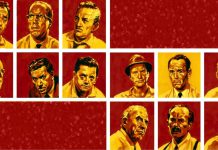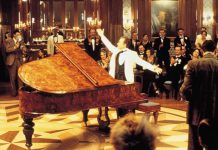在六十年代 在设计中使用 2 – 3 个图层是一件极为麻烦的事情
We had the greatest problem in the sixties to bring two or three layers into the work.
你需要求助于摄影技术 用尽一切疯狂的技巧
You need to do it by photograph, you did all kinds of crazy techniques
做一张海报要花好几天
and working on a poster took us days.
而现在 不到一个半小时 你就可以有不同的创意 做出几个备选设计
And now within half an hour you have your ideas and you can make variations
然后选出一个最好的
and make a good choice.
计算机不能帮你做出更好的设计
You can’t do better design with a computer,
但可以极大地提升你的工作效率
but you can speed up your work enormously.
我可以开始了吗? -好的
Shall I begin? – Sure.
这是我设计的几张关于荷兰风格派运动的邮票
I made these post stamps on the Stijl movement.
在开始的时候 你看看这些草图
In the beginning, if you see the sketches,
我原本打算用凡·杜斯堡的字体 一名荷兰的风格派运动艺术家
I tried to use typefaces from van Doesburg, one of the artists of the Destijl movement.
然而在最终稿中 我决定
Then I decided for the final designs
放弃这些字体 因为插画本身已经表明了它的时代
not to use these typefaces because the illustration is already from that period,
最后我用了最中性的一款字体:Helvetica
and I used the most neutral typeface, Helvetica.
相对于十九世纪的那些字体 Helvetica 是一个非常重要的突破
Helvetica was a real step from the nineteenth-century typefaces.
稍微有一点机械的味道
It was a little more machined,
没有太多人工的痕迹
it was doing away with these manual details in it,
它给我们留下很深的印象 因为它更为“中性”
and we were impressed by that, because it was more neutral.
而中立主义 是我们喜爱的一个字眼 懂吧
And neutralism was a word that we loved. You know.
它就应该是中立的
It should be neutral;
它本身不应该包含任何含义 它应该…
it shouldn’t have a meaning in itself. It should…
含义应该来自于文本的内容中 而非字体的表象
the meaning is in the content of the text, not in the typeface.
这正是我们如此喜爱 Helvetica 的原因
That’s why we loved Helvetica very much.
向人们解释我的职业总是要费我很多的口舌
I have to say that for a lot of my life
我很害怕向别人解释我的工作
I rather dreaded the moment of having to explain to someone…
比如说 在飞机上 或是火车上 你遇到了一个很好的邻座
you know, you find yourself sitting next to some nice person on a plane
他们总是免不了会问及你的职业
or a train and they ask you sooner or later what you do
如果你说自己是一个字体设计师 通常他们的表情是一脸茫然
and if you say type designer, they generally look completely blank.
不过偶尔 也会有人能真正理解这个术语
Occasionally, someone will actually know the term
但接着他们会说:“我以为他们都死光了”
but then will say, “I thought they were all dead.”
马修·卡特
从九十年代中期开始
Since I did some work for Microsoft
我为微软开♥发♥屏幕字体
in the mid-nineties on screen fonts,
主要是 Verdana 和 Georgia
particularly Verdana and Georgia,
我有过好几次很搞笑的偶遇 他们会说
I’ve had quite comical encounters with people who will say,
“噢 你就是做字体的
“Oh, you work with fonts.
我们办公室贴满便签 提醒我们都要开始用一种叫做 Verdana 的东西
We just got this memo round the office saying we’ve all got to start using something called Verdana.
你听说过吗?”
Have you ever heard of it?”
而在三、四十年前 我就不会遇到这样搞笑的谈话
Funny conversations that never would have happened to me thirty, forty years ago.
我的父亲是一个字体排印师 不过他并没有逼着我子承父业
My dad was a typographer, and although he didn’t push me to follow in his footsteps
哈里·卡特
那时我在英国的高中毕业 在去读大学之前我有一年的空闲
when I left school, high school in the UK, I had a year to fill before going to university
在这段时间我作为一个没有薪水的实习生
and I got sent as a trainee, an unpaid trainee, intern,
去荷兰一家造字厂实习
to a type foundry in the Netherlands,
我花了整整一年时间 学习一种后来被证明毫无用处的手艺
where I spent a year learning what turned out to be a completely obsolete trade
手工造字
of making type by hand.
每天做的就是切割钢铁的字模 按实际尺寸雕刻
It was a matter of cutting letters in steel, engraving them at actual size.
我怀疑那时我在那里一整天都做不出一个字母
You know, I doubt if I ever got up quite to one letter a day at that time.
所以我可以说 我已经亲身经历了所有的造字方式
So, you know, I could say that really I’ve made type by practically all the means
在我工作的这 50 年、51 年里
it’s ever been made in the fifty, fifty-one years that I’ve been working.
很难用一两句话说明字体设计师的工作方式
It’s hard to generalize about the way type designers work.
我们的工作方法不尽相同
There isn’t a generality of us.
但是我想从事这一行的大多数字体设计师
But I think that most type designers if they were sitting in this chair
大体上来说都是这样开始的
would essentially start in much the same way.
我通常会从一个小写的 h 开始
I’d probably start with a lowercase h.
它会告诉我们一些信息 首先 这是一个“无衬线”还是“衬线”字体
it tells me, first of all, whether this is a sans-serif or a serif typeface.
如果是一个“衬线字体” 它应该是这样的
If it were a serif face it would look like this
这就是所谓的“衬线” 这些小小的“脚”
here are the serifs so called, these little feet
在字母主干笔画的底部和顶部
on the bottom and top of the principal strokes of the letter.
它是粗体吗 还是一个细体 这种衬线体有什么特性
Are they heavy, are they light, what is the nature of the serif,
在字形上是否有着粗细的对比
is there a lot of thick-thin contrast in the letter form;
整体高度比例如何 h 的“上伸部”占多少
what are the proportions of the overall height, the ascender, so-called of the h,
与 x 等高部分占多少
and the x-height part of it,
然后由于 h 是一个直线边的字母
Then because an h is a straight-sided letter,
我会做一个圆形的字母 比如说一个 o 放在它旁边
I would then do a round letter like an o along side it.
我就可以直观的比较 o 曲线部分的“重量”是否能匹配 h 的直线部分
I can get a sense of how the weight of the curved part of the o relates to the straight part of the h.
仅仅这样一对简单的字母 就携带着大量决定这套字体外形的基因
And already there is a huge amount of DNA is just a couple of letterforms like that.
然后我可能会做一个小写的 p
I’d then probably do something like a lowercase p
因为它一半是直边 一半是圆形的
because it’s half straight and half round;
同时 它还有一个“下降部”
and also it has a descending stroke,
这是我想要确立的另外一个“垂直维度”
which is another vertical dimension that I would be interested in establishing.
然后我就以此为依据 接着往下做
I would then build on that.
如果你有了一个 h 你就已经拥有了极其丰富的信息
If you’ve got an h you’ve got an awful lot of information
足以建立这些小写的 m、n、和 u
about m, n, and u in the lower case.
你有了一个 p 就等于有了一个 q 和 b 还有 d 等等 依此类推
You’ve got a p you’ve got q and b and d and so on.
然后 我会尽早地把它们匹配成单词
And then just as soon as possible I would get them into words
或是让它们看起来像单词
or something that looked like words
因为如果要评判一款字体 它的阅读体验是至关重要的
because for me the experience of reading something is so critical in judging it as a typeface
我认为这是评价一款字体性能表现的“酸性测试”
because I find that is the acid test of how a typeface performs.
对我而言 Helvetica 最迷人的特质之一
One of the most characteristic and to my mind beautiful things about Helvetica
就是它水平的收尾 你可以在小写的 a、c、e 和 g 中看到
is these horizontal terminals, you see in the lower case a and c and e and g.
正是末端的这种水平切削决定了字体的整个结构走向
The whole structure is based on this horizontal slicing off of the terminals.
一个字体设计师看到这些字符 禁不住要问自己:
It’s very hard for a designer to look at these characters and say,
我还能怎样改进它们?我还能怎样让它们有所不同?
how would I improve them? How would I make them any different?
它们看上去是那样的完美
They just seem to be exactly right.
我很庆幸没人找我去…
I’m glad no one asked me to…
预言 Helvetica 的未来
to second-guess Helvetica
因为我实在不知道该怎么做
because I wouldn’t know what to do.
这是 Helvetica 最原始的样稿
This is the original type specimen of Helvetica
在它成为 Helvetica 之前 它有个原始名称:Die Neue Haas Grotesk
before it was Helvetica. It had its original name, Die Neue Haas Grotesk.
Helvetica 诞生的整个故事
The whole story of how Helvetica came into being
并不是很清晰的 至少对我而言
is not entirely clear, at least to me.
据说 不过我确信是事实
It is said, and I think it’s true,
爱德华德·霍夫曼 Hass 造字厂当时的老板
that Eduard Hoffmann, who had been the boss at Haas type foundry,
爱德华德·霍夫曼
他想为 Akzidenz Grotesk 这款字体做一个现代的版本
wished to make a modernized version of Akzidenz Grotesk,
那是一款传统的十九世纪德国无衬线字体
which was essentially a traditional nineteenth-century German sans-serif,
他的想法是让它的外形更简炼一些之类的
and his method of doing that was sort of to clean it up and so on.
当然 最后是马克斯·米丁格动手绘制了 Helvetica 的图样
And it was of course Max Miedinger who made the drawings for Helvetica.
我记得我在六、七十年代认识的一些人这么说过
I received the impression from people I knew back in the sixties and seventies
当年霍夫曼在其中承担的角色其实是相当重要的
that Hoffmann’s part in this was a very much more significant one
并非像你在那些教科书中看到的那么简单:
than you might just assume by reading in a textbook
“Helvetica 由马克斯·米丁格设计”
that Max Miedinger was the designer of Helvetica.
明兴施泰因,瑞士
Haas 造字厂旧址
Helvetica 在此诞生
你可以很确定地说
You can easily say
这是共同创作
this was a joint product
阿尔弗雷德·霍夫曼
Haas 造字厂前任主管
由米丁格和我父亲共同完成
of both Miedinger and my father.
米丁格无法单独完成一个字体的设计
Miedinger couldn’t produce a typeface alone;
我父亲也不行
neither could my father.
但如果是两个人在一起共同努力 就能够有所成就
But when both were working hard together then something good resulted.
这就是当年的第一个测试版本:Neue Haas Grotesk
Here are the first trials of Neue Haas Grotesk,
这才是 Helvetica 的原名
which was the first name of Helvetica.
我熟悉 Haas 造字厂的工作流程
I knew the way things worked at Haas
所以我逐渐发现了爱德华德·霍夫曼在其中发挥的重要作用
and I had gradually picked up on the importance of Eduard Hoffman,
迈克·帕克
美国 Mergenthaler Linotype 公♥司♥
字体排印部总监, 1961-1981 年
由于他那种几乎是病态的羞怯
and his almost pathological shyness
他喜欢借助他人之手来进行工作
and the way that he would use other people’s hands.
但是 天啊 你仍然能从这些字体工作中看出
But boy could you see his mind at work on the faces
这里面浸透着他的心血
where he was deeply involved.
这是他当年的一张便条
You have here a note by Eduard Hoffmann
都是他的修改建议
indicating all the desired corrections.
“大写 Y 太过纤细”
“The capital Y is too slim.
“大写 A 也是过细”
Capital A is also too slim.”
当我们谈论 Haas Neue Grotesk 或者说 Helvetica 的设计的时候
When you talk about the design of Haas Neue Grotesk or Helvetica,
我们实际上谈论的是它们与其“负形”之间的相互关系
what it’s all about is the interrelationship of the negative shape
实体与空间之间的关系
the figure-ground relationship,
字体内部 以及字体之间的空间形态
the shapes between characters and within characters,
以及黑色部分 如果你喜欢这样称呼的话;和过墨的部分
with the black if you like, with the inked surface.
而瑞士人更关注于字体的负形
And the Swiss pay more attention to the background,
所以字谷与字形间的空间就把整个字母固定住了























